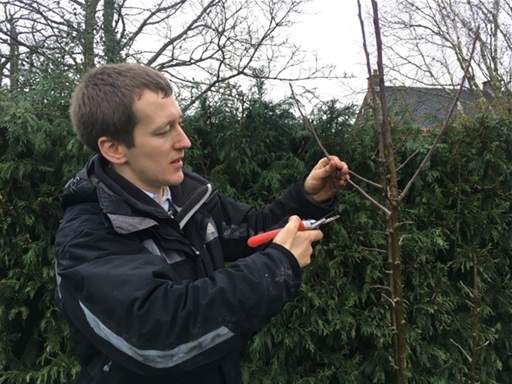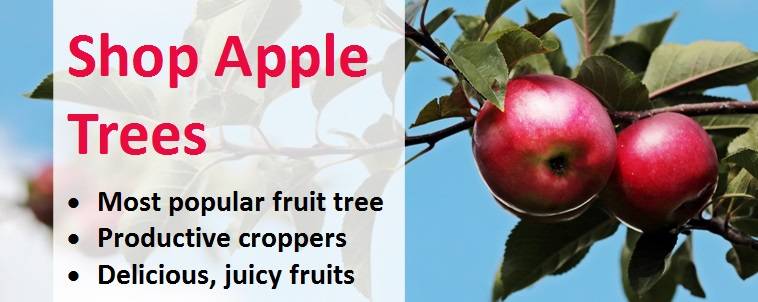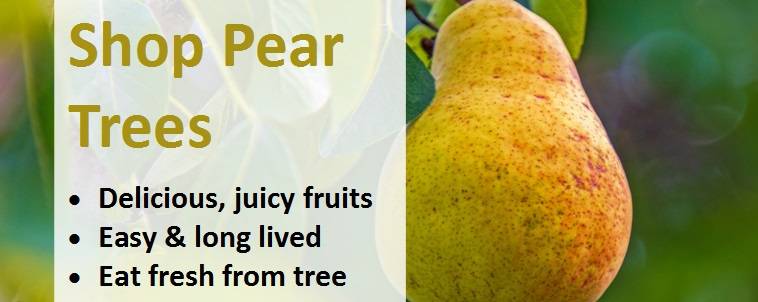Check Here Before Buying – Pot Size Matters...Not all websites offer the same. Plants in a 2-litre pot have twice the root system of a P9 or 1 litre pot.
How to prune apple and pear trees
Apple trees and pear trees grown as a free-standing bush or standard trees should be pruned between late autumn and early spring to promote a healthy shape, encourage flowering and ensure a good cycle of fruiting wood. The aim is to create an open, vase-shape framework of 4-5 main outwardly facing branches which are not too congested and through which wind can pass through freely. Trees left unpruned become less productive as they become congested with older branches.
Trees grown in other forms such as cordons, fans and espaliers are best pruned in the summer. Before commencing winter pruning, make sure the tree is dormant - the leaves have fallen (if you're pruning in late autumn) and buds have not started to develop (if you've left it to early spring).

Pruning Apple and Pear Trees grown as a bush or standard
1) Make sure you have clean, sharp tools
- You'll need: secateurs, loppers or a pruning saw (for larger trees), telescopic pruner or step ladders for higher branches.
- Sharpen your tools if needed before you start to prune - blunt tools are more likely to snap branches, letting in pests and diseases that will harm your tree.
2) Remove suckers and lower branches
- Use secateurs to cut back suckers - unwanted shoots that grow near the base of the trunk.
- Remove all shoots up to the base of the main canopy of the tree to encourage a good shape.
- Lower branches will not produce good fruit because they do not get enough light.
- Always cut outside the 'collar' leaving just one-quarter of an inch (0.5cm) as cuts made too close to the stem may not heal. Avoid leaving larger stumps which decay and harbour pests/diseases.
3) Remove dead, diseased and damaged wood
- Remove all branches with discoloured or flaking bark towards the base of the branch, making a cut above an outward-facing bud. Remove the whole branch if it doesn't have any buds.
- Angle each cut so rain can drain off the stem rather than sitting on the top and rotting your tree.
4) Remove crossing or rubbing branches
- Take out any branches growing into the centre of your tree to enable better air circulation around the framework of branches and allow light to reach ripening fruit.
- If 2 outward branches are crossing, keep the one that best retains the vase-shape of your tree.
- Leave any branches larger than 20cm in diameter and prune larger branches in stages to prevent snags.
5) Creating an open, vase-shape framework of 4-5 main branches
- If you have more than 5 main (primary) branches, remove some at the base cutting one-quarter of an inch from the 'collar'. Keep the branches that best retain the desired open vase shape.
- Every few cuts stand back to check your work and consider where to prune next.
- Avoid removing more than 25% of branches in one go. Overly zealous pruning can affect a tree's health and reduce fruit production. If more pruning is needed spread it out over a few years.
6) Shorten previous year's growth on each main branch by one third
- Cut just above an outward-facing bud so new branches grow outwards
- This will encourage new branches to develop in a health shape and prevent the centre of your tree from getting congested.
7) Remove weak and unproductive spurs
- Leave young side-shoots (laterals) off the main branches unpruned so they can develop fruit buds in the second year.
- Only remove side-shoots if they are crossing, congested and on the underside of branches where fruits will not receive enough light to fully develop.
8) Final step for tip-bearing fruit trees
- To introduce this final step it's first important to understand the difference between spur-bearing and tip-bearing fruit trees.
- Most fruit trees are spur-bearing and produce fruit buds on two-year old wood and spurs (short fruiting side-shoots) on older wood. Spur bearing apple trees include James Grieve and Cox's Orange Pippin.
- Tip-bearing trees are less common and produce fruit buds at the tips of long shoots produced the previous year.
- Many apple trees are partial tip-bearers, meaning that they produce fruit both on spurs and on the tips of the previous years' growth - i.e. a combination of the two. Partial tip-bearers include Discovery and Bramley's Seeding.
- When pruning tip-bearing or partial tip-bearing fruit trees only, prune some of the older fruited branches to strong younger branches closer to the main trunk. This will help rejuvenate fruit production, prevent branches from getting too long and reduce congestion.
Share this page:


